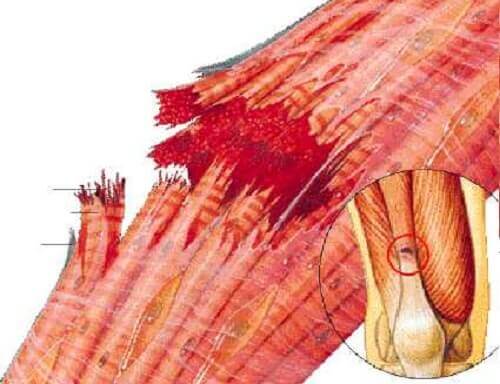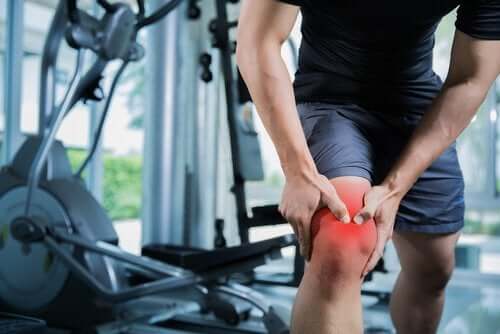Muscle Strain: Symptoms and Treatments


Reviewed and approved by the biotechnologist Alejandro Duarte
A muscle strain, commonly called muscle pull, is the partial or complete tear of the myotendinous junction, which is the transition zone between the muscle and the tendon. When a muscle is subjected to an exaggerated stretch, it results in the breakage of muscle fibers. The adjacent structures, such as tendons or blood vessels, may also be affected. Then, a bruise often occurs in the damaged area.
These injuries are due to a dynamic overload, often accompanied by sudden changes in intensity and position. This is usually due to the frequent excessive effort in high-intensity sports such as basketball, football, or track.
Overall, there are three different degrees of muscle strain depending on the level of breakage:
- Mild or first-degree muscle strain: This is a microscopic breakdown of muscle fiber. However, the tendon and adjacent blood vessels remain unharmed.
- Moderate or second-degree muscle strain: In this case, there’s a partial breakage of muscle fiber and adjacent ligaments. Then, a bruise occurs as a result of the ruptured blood vessels. Here, the mobility of the affected area is compromised.
- Severe or third-degree muscle strain: This is the complete breakdown of muscle fiber and ligaments with total or near-total loss of function. For this reason, a visible bruise and inflammatory reaction will occur.
Muscle Strain

The symptoms of a pulled muscle depend on the degree of muscle fiber breakage. Therefore, we’ll proceed to classify them according to the level of tear:
- First-degree: In this case, there is no loss of functionality and full mobility of the injured area is maintained. There’s only slight inflammation accompanied by some discomfort. However, the injured person may not identify it until they finish their physical activity or even until the next day.
- Second-degree: In this case, the function is partially affected and there’s loss of mobility. Also, there’s a pain when feeling the affected area and also inflammation and hematoma. Typically, the patient is aware of the injury as soon as it occurs and they have to stop their physical activity.
- Third-degree: This is the partial or total loss of mobility in the affected area. There is bruising and hematoma, as well as a lot of pain. The person notices the injury immediately. They also may detect irregularities in the muscle tissue upon feeling it.
Read more: Everyday Habits that Cause Knee Pain
Treatment
The treatment of a muscle strain will depend on the time elapsed since the injury occurs, as well as the degree of muscle fiber breakage. In all cases, you should apply ice to lessen the pain.
The main treatments applied in each case are:
First-Degree
During the first days, you should apply ice and compress the affected area, and you should also rest, elevate it and do isometric exercises. All of these put the muscle under tension without having to move it.
Then, you’ll need some mild to moderate physical activity with the aim of progressively returning to normality. Some of the recommended activities include pool exercises, gentle stretching, and light weight lifting. The application of anti-inflammatory drugs isn’t usually necessary since the pain is mild.
Second-Degree Muscle Strain

As in the case of a mild strain, you should apply ice and compress the affected area during the first 2-3 days. Also, rest and maintain it elevated. From the fourth day, you can start doing isometric exercises. Do so carefully and stop the activity if you feel pain.
For the next two weeks, physicians usually recommend moderate physical activity until you fully recover your mobility. They may prescribe medications to treat inflammation and pain.
Read more: Heal a Sprained Ankle with Complementary Remedies
Third-Degree
During the first few days, you should follow the same protocol we mentioned above. You’ll need full rest, and if you must walk, then do so with crutches, depending on the severity of your injury.
Later, you can gradually do isometric exercises in the second week. Subsequently, you can incorporate physical activity progressively, until you make a full recovery, the same that should occur around the fourth week. Doctors will, most likely, also recommend the use of anti-inflammatory drugs.
In all cases, the most important thing is to follow your doctor’s advice.
All cited sources were thoroughly reviewed by our team to ensure their quality, reliability, currency, and validity. The bibliography of this article was considered reliable and of academic or scientific accuracy.
- Almekinders, L. C. (1999). Anti-inflammatory treatment of muscular injuries in sport. An update of recent studies. Sports Medicine. https://doi.org/10.2165/00007256-199928060-00001
- Nicholas, S. J., & Tyler, T. F. (2002). Adductor muscle strains in sport. Sports Medicine. https://doi.org/10.2165/00007256-200232050-00005
- Erickson, L. N., & Sherry, M. A. (2017). Rehabilitation and return to sport after hamstring strain injury. Journal of Sport and Health Science. https://doi.org/10.1016/j.jshs.2017.04.001
This text is provided for informational purposes only and does not replace consultation with a professional. If in doubt, consult your specialist.








